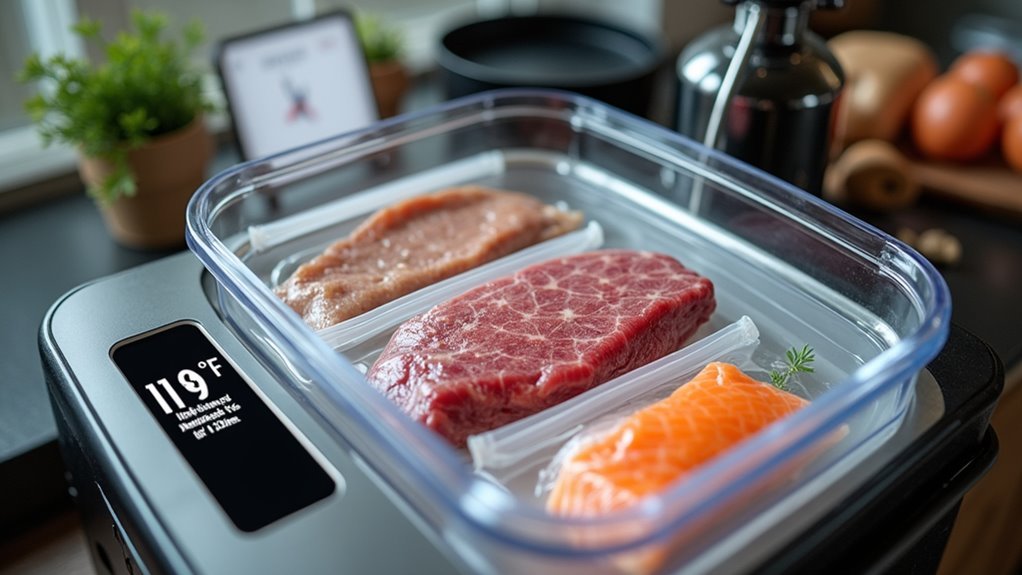Sous vide transforms chicken piccata into a foolproof masterpiece. You’ll want to season bone-in thighs generously, then cook at 74°C/165°F for 1.5 hours (add an hour for frozen). The water displacement method works best for sealing bags with marinades. After cooking, pat thighs thoroughly dry before searing to develop that perfect crust. Finish with a bright piccata sauce of lemon, butter and capers added at the last minute. These techniques reveal restaurant-quality results every time.
The Perfect Sous Vide Chicken Thigh Selection

When it comes to creating the perfect chicken piccata, your choice of chicken thighs can make all the difference in the final dish.
I’ve found that bone-in thighs generally deliver more flavor and juiciness than their boneless counterparts, particularly that meat right around the bone—it’s incredibly tender!
That said, don’t worry if you only have boneless thighs on hand. They’ll work just fine with the same cooking time and temperature (74°C/165°F for about 1.5 hours).
Frozen chicken? No problem—just add an extra hour to guarantee everything cooks through properly. However, keep in mind the potential environmental impact of sous vide cooking, as the significant amount of water used can contribute to overall wastefulness.
Mastering the Sous Vide Bag Sealing Technique
Two critical aspects of successful sous vide cooking lie in proper bag sealing technique.
You’ll need to guarantee your food is securely sealed to prevent water from getting in and flavors from leaking out. I’ve found that both vacuum sealers and the water displacement method work well, though each has its quirks.
When preparing your chicken piccata, consider these essential sealing tips:
- If using a vacuum sealer, check if it handles liquids – many don’t!
- For the displacement method, gradually lower your Ziploc bag into water.
- Leave a small opening at the top until air escapes.
- Seal just before the water reaches the bag’s opening.
Additionally, using a vacuum sealer reduces the risk of freezer burn, ensuring your ingredients maintain their flavor and freshness during storage.
Chicken Piccata Seasoning Essentials
Although seasoning may seem like a minor detail, it forms the foundation of a memorable chicken piccata. The right blend of salt, pepper, and herbs brings your chicken thighs to life before they even hit the water bath.
Remember, some seasoning diminishes during sous vide cooking, so don’t be shy with your initial application. I think it’s always better to re-season before searing anyway, which gives you a second chance to perfect the flavor profile. Additionally, ensure your chicken isn’t high moisture content to prevent spoilage during storage.
When searing after the bath, pat those thighs completely dry first. Otherwise, you’ll steam rather than sear, and perhaps miss out on that beautiful golden crust.
Sous Vide Temperature and Timing Guide

Perfectly controlling the temperature and timing of your sous vide bath is essential for achieving that melt-in-your-mouth chicken piccata I’ve come to love.
It’s really all about precision, I think.
For chicken piccata success, follow these guidelines:
- Set your sous vide to 74°C/165°F for juicy, safe results
- Cook bone-in thighs for 1.5 hours (they’re more flavorful!)
- Add an extra hour (2.5 total) if using frozen chicken
- Pat dry thoroughly before searing for that perfect finish
Perhaps the most important thing is consistency.
Incorporating vacuum sealing techniques allows for enhanced flavor and preservation, ensuring your meals are always top-notch.
Once you’ve nailed these timings, your piccata will turn out perfect every time.
The Art of Post-Sous Vide Searing
Once you’ve mastered the sous vide portion of chicken piccata, searing becomes your final—and perhaps most vital—step toward culinary perfection.
This quick finishing touch transforms your perfectly cooked chicken into a masterpiece with gorgeous color and enhanced flavor.
Pat those thighs completely dry with paper towels first—this is essential. Moisture is the enemy of a good sear! Re-season generously, as some of your initial seasoning may have diminished during the sous vide process.
Heat your pan until it’s screaming hot, then sear each side for just 30-45 seconds.
I’ve found cast iron works wonderfully here, but any heavy-bottomed pan will do. Additionally, using vacuum sealing for the chicken prior to sous vide can help preserve its moisture and flavor throughout the cooking process.
Crafting the Signature Piccata Sauce
While the chicken is undeniably the star of piccata, the sauce is what transforms this dish from merely good to absolutely unforgettable. That bright, tangy flavor profile creates magic when paired with tender sous vide chicken thighs.
To craft your perfect piccata sauce:
- Start with the fond created during searing – those browned bits are flavor gold.
- Balance acidity with butter’s richness – I think about 2 tablespoons per serving works well.
- Use fresh lemon juice, never bottled – the difference is remarkable.
- Add capers at the very end to preserve their briny pop.
Perhaps the best part? You can adjust the sauce thickness by reducing it further if you prefer a more concentrated flavor. Additionally, sous vide cooking allows for optimal food preservation, ensuring your chicken remains juicy and flavorful.
Frequently Asked Questions
Can I Make Chicken Piccata Ahead for a Dinner Party?
Hosting a dinner party soon? You can absolutely make chicken piccata ahead. Sous vide the chicken, refrigerate it for a few days, then simply sear and sauce when you’re ready to serve.
How Do Leftovers Reheat Without Losing the Crispy Texture?
To reheat leftovers without losing the crispy texture, you’ll want to separate the chicken from sauce, reheat it in a 350°F oven until warm, then recrisp with a quick pan sear.
What Wine Pairs Best With Sous Vide Chicken Piccata?
Over 80% of wine enthusiasts prefer white wines with chicken piccata. You’ll enjoy a crisp Pinot Grigio, Sauvignon Blanc, or unoaked Chardonnay that complements the dish’s lemony, buttery flavors perfectly.
Are There Dairy-Free Alternatives for the Traditional Piccata Sauce?
Yes, you can make dairy-free piccata by using olive oil instead of butter and thickening with cornstarch or flour. Plant-based butters or coconut cream also work well as substitutes.
Can I Use Chicken Breasts Instead of Thighs?
Yes, you can use chicken breasts instead of thighs. You’ll need to adjust cooking time to about 1 hour at the same temperature for juicy results without overcooking.
